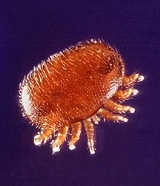
Varroa destructor
Overview
Mite
Mites, along with ticks, are small arthropods belonging to the subclass Acari and the class Arachnida. The scientific discipline devoted to the study of ticks and mites is called acarology.-Diversity and systematics:...
that attacks honey bee
Honey bee
Honey bees are a subset of bees in the genus Apis, primarily distinguished by the production and storage of honey and the construction of perennial, colonial nests out of wax. Honey bees are the only extant members of the tribe Apini, all in the genus Apis...
s Apis cerana
Apis cerana
Apis cerana, or the Asiatic honey bee , is a species of honey bee found in southern and southeastern Asia, such as China, India, Japan, Malaysia, Nepal, Bangladesh and Papua New Guinea. This species is the sister species of Apis koschevnikovi, and both are in the same subgenus as the Western honey...
and Apis mellifera. The disease caused by the mites is called varroatosis.
Varroa destructor can only replicate in a honey bee colony. It attaches at the body of the bee and weakens the bee by sucking hemolymph
Hemolymph
Hemolymph, or haemolymph, is a fluid in the circulatory system of some arthropods and is analogous to the fluids and cells making up both blood and interstitial fluid in vertebrates such as birds and mammals...
. In this process RNA virus
RNA virus
An RNA virus is a virus that has RNA as its genetic material. This nucleic acid is usually single-stranded RNA but may be double-stranded RNA...
es such as the deformed wing virus (DWV)
Deformed Wing Virus
Deformed wing virus is an RNA virus, one of 18 known viruses affecting the honey bee, Apis mellifera. The virus was first isolated from a sample of symptomatic honeybees from Japan in the early 1980s and is currently distributed worldwide....
spreads to bees. A significant mite infestation will lead to the death of a honey bee colony, usually in the late autumn through early spring.

